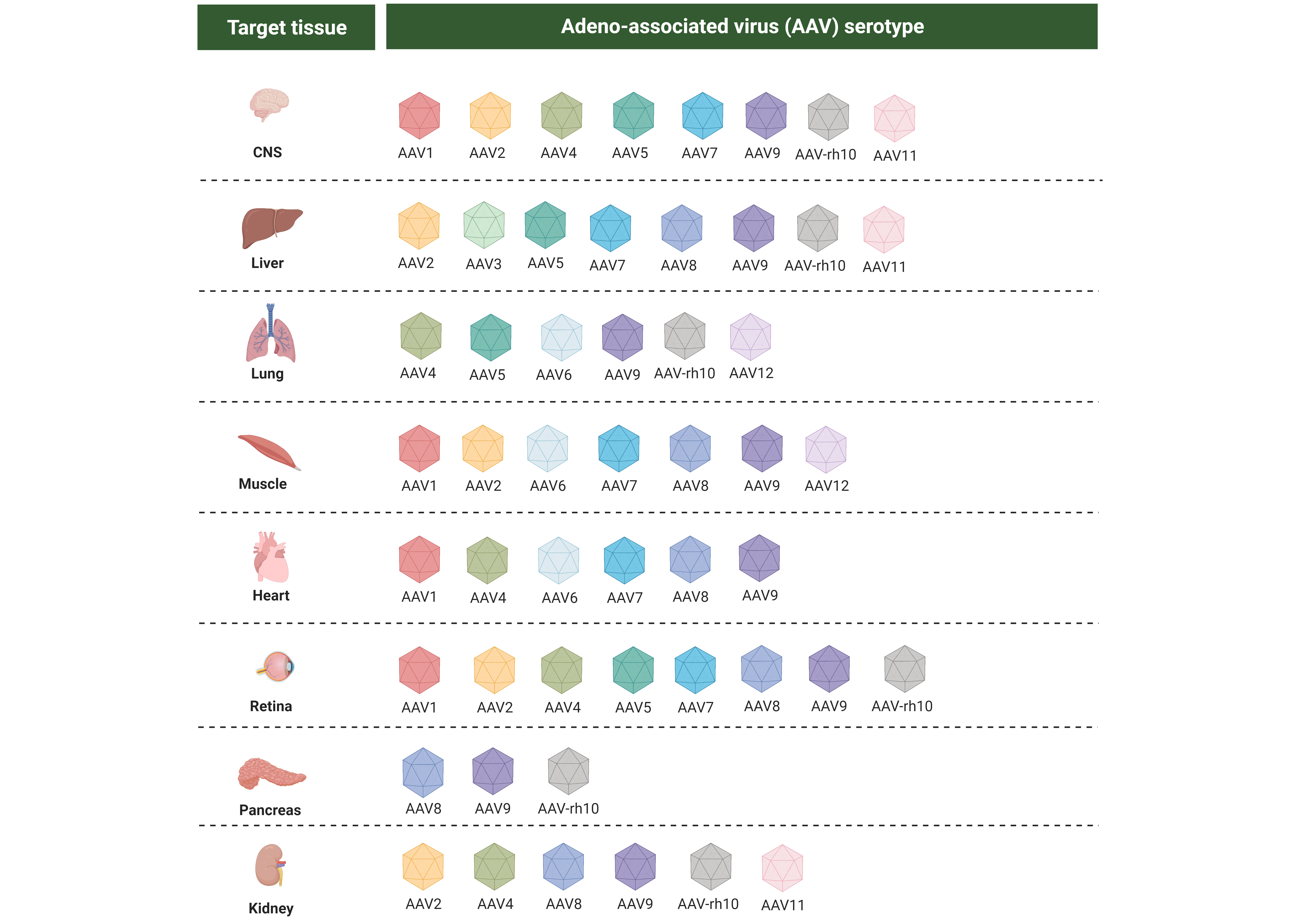AAV Products and Services
What is AAV?
Adeno-associated virus (AAV) is a small, non-enveloped virus with a single stranded DNA genome. This virus is commonly used as an efficient vehicle to mediate DNA delivery into mammalian cells, both in vitro and in vivo.
Benefits of Using AAV
- Tissue Specificity
- High Transduction Efficiency
- Long Term/Stable Gene Expression
- Low Immunogenicity
- Non-pathogenic

How does AAV gene delivery work?
AAV particles deliver your gene of interest and promote expression in a tissue-specific manner. Watch our webinar and download our free e-book below to learn more about AAV.
AAV Serotype Selection Guide
One of the useful features of AAV is its serotypes, which defines the preference of the types of cells/organs they infect. The tables below provide the selection guide for in vitro and in vivo applications.
| Cell Line | AAV-1 | AAV-2 | AAV-3 | AAV-4 | AAV-5 | AAV-6 | AAV-8 | AAV-9 | AAV-DJ | AAV-DJ/8 |
|---|---|---|---|---|---|---|---|---|---|---|
| Huh-7 | 13 | 100 | 2.5 | 0.0 | 0.1 | 10 | 0.7 | 0.0 | 500 | 0.2 |
| HEK293 | 25 | 100 | 2.5 | 0.1 | 0.1 | 5 | 0.7 | 0.1 | 500 | 0.3 |
| HeLa | 3 | 100 | 2.0 | 0.1 | 6.7 | 1 | 0.2 | 0.1 | 667 | 0.2 |
| HepG2 | 3 | 100 | 16.7 | 0.3 | 1.7 | 5 | 0.3 | ND | 1250 | 0.5 |
| Hep1A | 20 | 100 | 0.2 | 1.0 | 0.1 | 1 | 0.2 | 0.0 | 400 | 0.1 |
| 911 | 17 | 100 | 11 | 0.2 | 0.1 | 17 | 0.1 | ND | 500 | 0.0 |
| CHO | 100 | 100 | 14 | 1.4 | 333 | 50 | 10 | 1.0 | 25000 | 5.0 |
| COS | 33 | 100 | 33 | 3.3 | 5.0 | 14 | 2.0 | 0.5 | 500 | 0.3 |
| MeWo | 10 | 100 | 20 | 0.3 | 6.7 | 10 | 1.0 | 0.2 | 2857 | 1.0 |
| NIH3T3 | 10 | 100 | 2.9 | 2.9 | 0.3 | 10 | 0.3 | ND | 500 | 0.1 |
| A549 | 14 | 100 | 20 | ND | 0.5 | 10 | 0.5 | 0.1 | 1000 | 0.1 |
| HT1180 | 20 | 100 | 10 | 0.1 | 0.3 | 33 | 0.5 | 0.1 | 333 | 0.2 |
| Monocytes | 1111 | 100 | ND | ND | 125 | 1429 | ND | ND | 100 | ND |
| Immature DC | 2500 | 100 | ND | ND | 222 | 2857 | ND | ND | 200 | ND |
| Mature DC | 2222 | 100 | ND | ND | 333 | 3333 | ND | ND | 100 | ND |
Note: Infectivity rates normalized to AAV-2 = 100. ND = Not Determined.
Grimm D, Lee JS, Wang L, et al. In vitro and in vivo gene therapy vector evolution via multispecies interbreeding and retargeting of adeno-associated viruses. J Virol. 2008;82(12):5887-5911. doi:10.1128/JVI.00254-08

Issa, Shaza et al. Various AAV Serotypes and Their Applications in Gene Therapy: An Overview. Cells 2023, 12, 785. https://doi.org/10.3390/cells12050785


